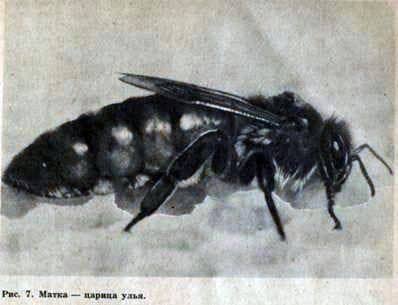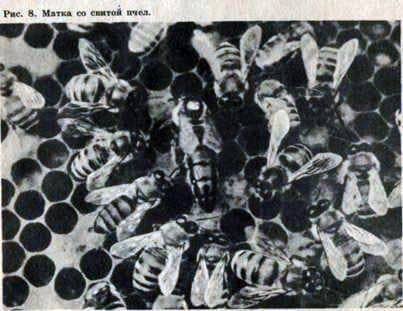Rod continues the uterus

Uterus is the main member of the family. It is often called even a queen or queen. It is very different from working bees. A long, round at the end rounded abdomen banded with light strips. The body of the uterus has a dark brown, and sometimes yellow, quite golden tone. It depends on her breed. According to the honeycombs, the uterus walks leisurely, majestically. And in size, it is almost twice the size of a worker’s bee. Wings cover only half of her body.
True, recently appeared on the light, another barren uterus looks different, it differs from the adult womb and its behavior. Her abdomen is small, thin, she is very mobile and agile, runs on the honeycomb faster than a worker’s bee, as if trying to hide from the world as soon as possible. Bees do not pay attention to it. But when the young uterus becomes fruiting, the attitude towards it changes completely.
Bees in front of her part, give way, wherever it goes, always turn in her direction with heads, try to come closer, vying with each other, offer a fetal feed to the uterus, gently touch it with antennae, tongues, clean it with paws, carefully take care of it, protect it. The uterus becomes, just a magnet. In whatever part of the nest it turned out, 8-10 bees are immediately grouped around it. This is the so-called retinue of the uterus, like the court suite of a real queen or queen.

Most of them are strong young bees with well-developed glands producing milk, which they feed the uterus always, even in winter.
The uterus is always in the focus of attention of working bees. There is a queen in the family – they clearly fulfill their duties, instantly react to all signals. The actions of the thousands of bee community are coherent and organized, as if it were not a cluster of insects, but a single organism. If there is no honey in the nest

But it is worth dying the uterus, as the life of the family is completely upset. Bees-orphans seem to lose the goal, which used to be for them above all else. They do not fly for nectar and pollen (only individual, still obeying the instinct, bring a thin renewal), do not build honeycombs, do not protect their nest from enemies, become helpless. The seal of doom lies on everything. And in the hive there is no longer any ordinary order and purity.
The womb is thus the organizing principle, the head and heart of the family. Without her, the bee family can not exist.
The uterus lays a huge number of eggs. There are such prolific specimens that put 3-4 thousand eggs a day, or even more.
The weight of the masonry is much greater than the mass of the uterus itself. Moreover, such an extremely high rate is maintained for a long time. The uterus turned into an egg-laying machine. If the domestic chicken had the same egg production, then we would receive 50-60 eggs per day from it.
But nature has freed the uterus from other worries. She does not collect nectar: she has a very short proboscis, half as long as a worker’s bee. She does not feed her offspring, she does not have glands giving off milk. And on the legs disappeared baskets, although her ancestors, when the bees lived alone, had them. Preserved only her rudiments of these organs, as evidence that in the past times the uterus performed all the work necessary for life and growing their own kind.
The size of the entire population of the hive depends on the uterus. If it is prolific, then by the beginning of the mass flowering of plants abundant in nectar, the family will be able to grow many strong bees capable of harvesting a rich harvest of nectar. The uterus is infertile and with poor heredity can not cope with these tasks. Her family will not procure the right amount of feed. The uterus, therefore, determines the quality of the family, its strength, efficiency and productivity, therefore in practical beekeeping it has the main role. Usually it is believed that if the family is behind in development from other families, then, in it, a bad uterus. This is quite fair.
The quality of the uterus can be determined to some extent by its appearance, in particular by the size of the insect. Small uterus, a little more than a working bee, small-bodied, with insufficiently developed organs of reproduction. Large, heavy, on the contrary, good uterus. A young barren, unseeded uterus is considered quite satisfactory, if its mass is not lower than 200 mg, but it is better if it weighs 220 mg.
The mass of good eggs, laying eggs, is close to 300 mg, that is, three times the mass of a working bee. For breeding, therefore, it is necessary to select the largest uterus. In good uterus, the abdomen at the end is rounded. Egg tubes of the uterus, in which the eggs ripen, are so long that they can not fit in the abdomen, if not rounded at the end. The more these tubes and they are longer, the fuller and more rounded the end of the abdomen. The uterus with a pointed abdomen has fewer egg tubes, and they are shorter, so the fertility of such queens is not high.
The uterus exhibits its qualities in the speed of laying eggs and the compactness of their placement. She begins to lay the eggs from the middle of the honeycomb – a waxy layer and, moving in a circle, lowers them into each free cell found on the way. The honeycomb is partially or completely filled with eggs. Well-mastered honeycomb, completely stuffed with brood, is an indicator of an excellent uterus.
If there are a lot of empty cells on the cell that are not occupied by the larvae, the uterus must be considered inferior. This she missed or put aside the inferior eggs that the bees had removed. The honeycomb looks riddled. It is unlikely that she will be able to make her family strong by the right time. At the first opportunity, it should be replaced with another one.
Many eggs lay uterus young, one-two-year-olds. Although the uterus can live 5-6, and even 7 years, already in the third year of life their fertility is markedly reduced. The older the uterus, the less it lays eggs, the weaker the family. The queens are therefore replaced with young ones no later than 2 years later. Only the most prolific ones are left for another year or two to get their daughters out of them.
The best uteri are considered to be swarms. They are grown by working bees, when they prepare for swarming, at the time of maturity of the family. Similar swarms can be withdrawn and artificially. Beekeepers have such methods.
Uterus of the desired breed is usually discharged from the breeding nurseries, which specially grow them for sale.
The uterus carries two kinds of eggs: fertilized, of which female individuals develop – working bees and uterus, and unfertilized, drones appear from these eggs.
Rod continues the uterus
